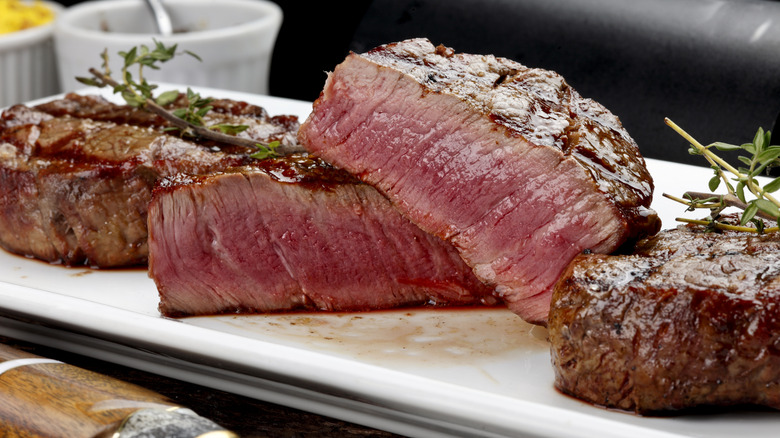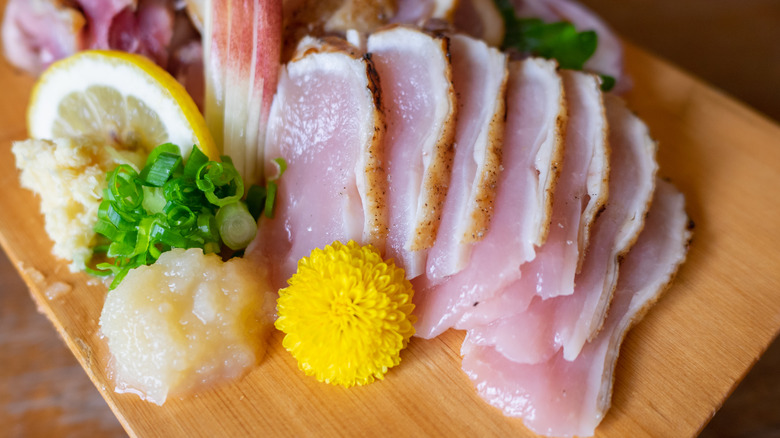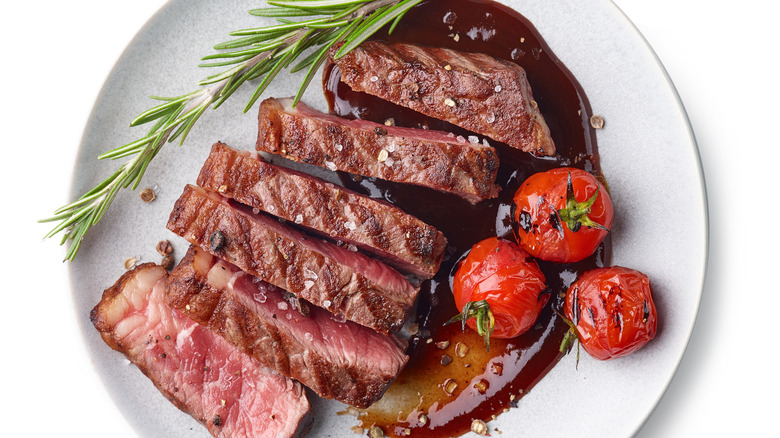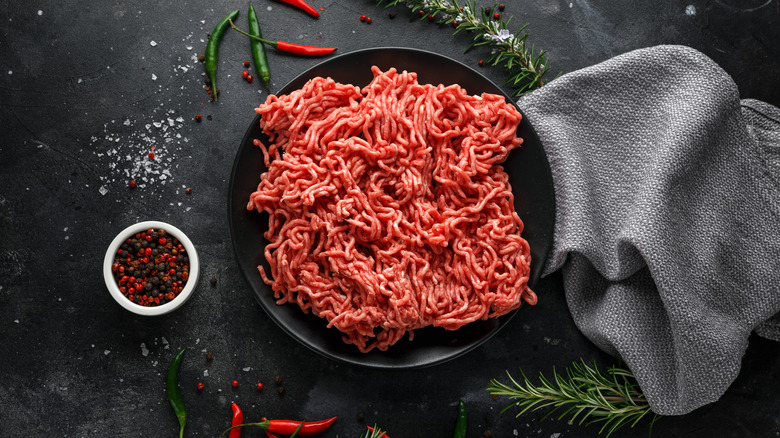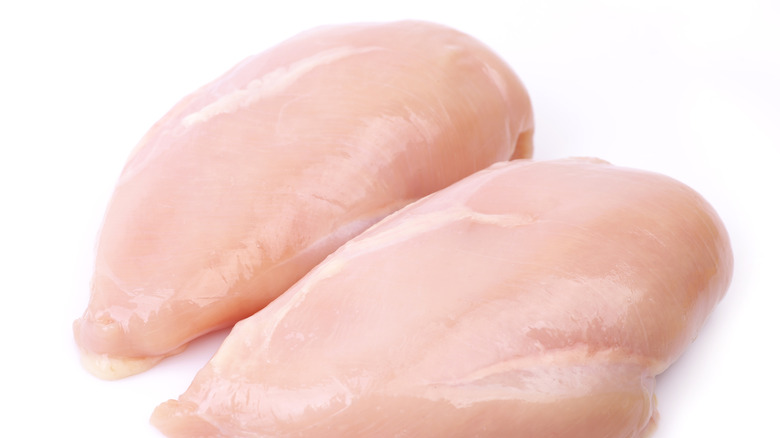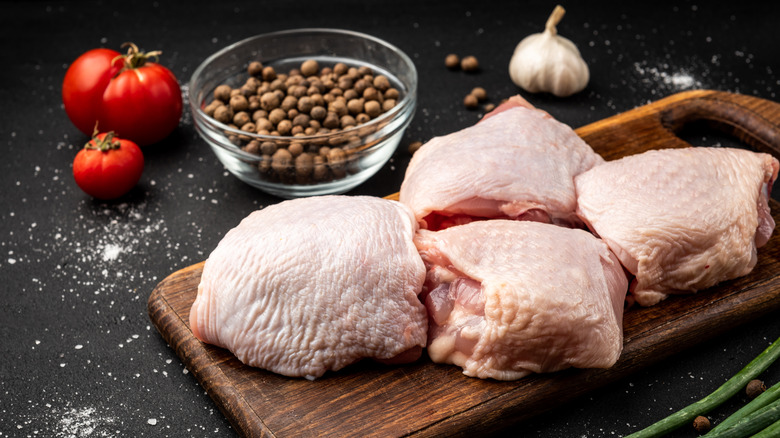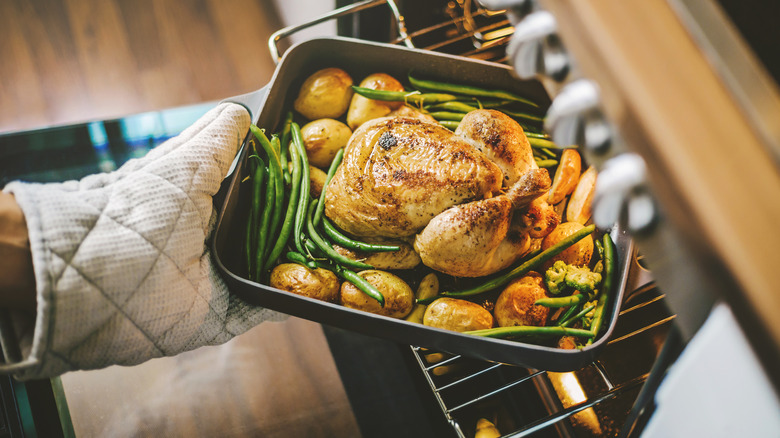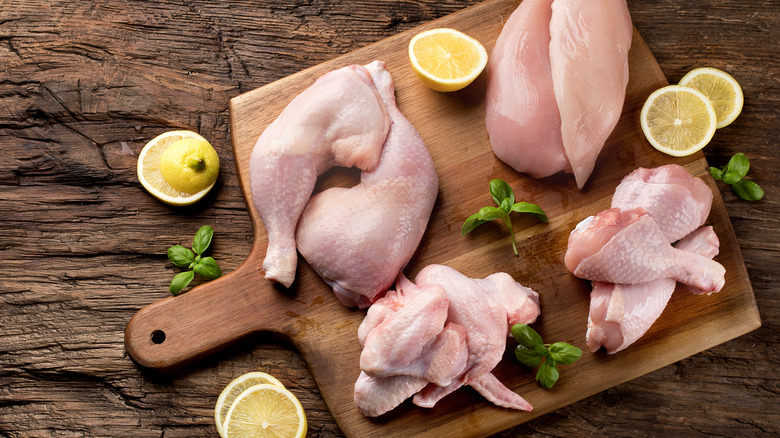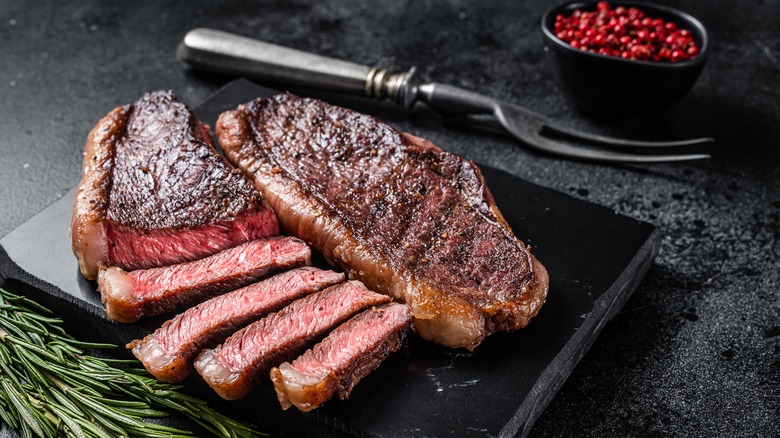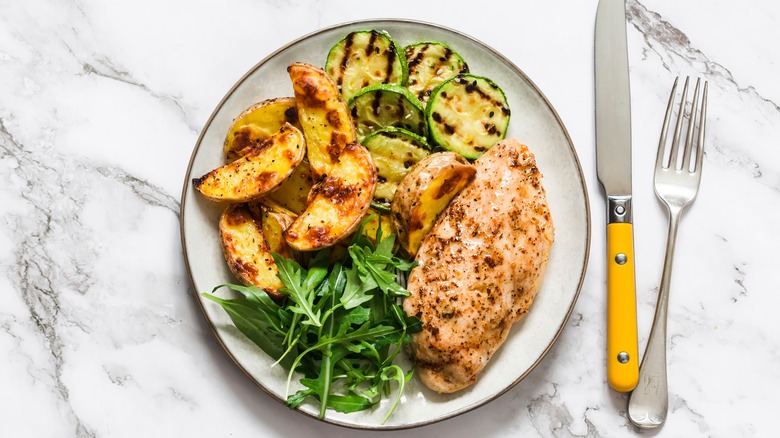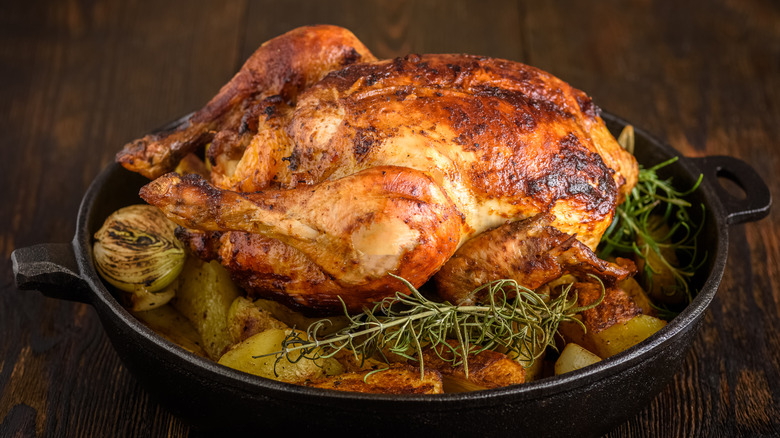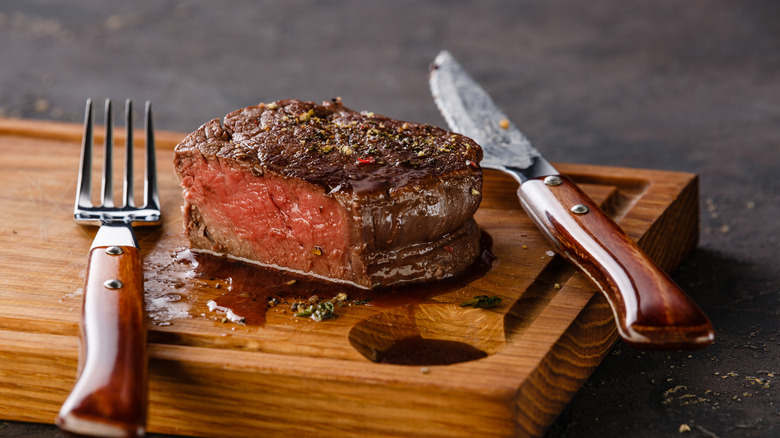The Real Difference Between Rare Steak And Rare Chicken
If you're a serious carnivore, you probably crave a rare or medium rare steak — a succulent treat that reveals deep red meat and releases blood-red juices when cut. And for many meat lovers, this is the best, if not the only, way to enjoy a steak. Indeed, there's a long tradition of eating barely-cooked steak. For instance, the infamous Pittsburgh steak (also known as the back-and-blue steak), is said to have been invented by the city's steelworkers. They reportedly cooked their midday steaks on their factories' white-hot smelting equipment until the meat was charred on the outside but nearly raw inside.
But of course, no one can (or should) live on steak alone. If you also enjoy chicken, you may have wondered why it's so rare to see that protein served rare. With a few exceptions, chicken always arrives on your plate fully cooked. A big reason for this — besides longstanding culinary tradition — is safety. As Francisco Diez-Gonazalez, director of the University of Georgia's Center for Food Safety, explained to Adam Ragusea, chicken flesh can carry pathogens such as salmonella. The only way to deactivate these is by thorough cooking. (Beef can carry pathogens too; however, these are typically restricted to the digestive tract and can be avoided by careful butchering practices.) But in case you've been seeing stories about daring diners enjoying rare or raw chicken and want to know what the fuss is about, here's what you need to know about the real difference between rare steak and rare chicken.
Yes, chicken sashimi is a thing — but it's not recommended
Believe it or not, there are actually some raw chicken dishes out there that aren't the result of fraternity pranks or cooking experiments gone wrong. According to Matador Network, chicken sashimi — raw or lightly seared sliced chicken breast — is a common offering in Tokyo's yakitori restaurants, which specialize in different sorts of seasoned chicken parts grilled over an open flame and served on skewers. The raw chicken — which is typically served with grated ginger, shiso leaves, and vinegar – is meant to be just another way to showcase the different possible flavors and textures of chicken.
But even as writer and diner Katy Severson turned into an enthusiastic apologist for this unusual preparation, Matador Network emphasizes that reputable yakitori restaurants are careful in how they source and prepare the chicken used for chicken sashimi. Eating it elsewhere can carry an unacceptable risk. Thus, one should never try raw chicken sashimi at a restaurant that does not specialize in it or make it at home from a random and possibly contaminated supermarket chicken. Even in Japan, food safety experts are rethinking the dish. Per Live Science, Japan's Ministry of Health, Labour, and Welfare has advised restaurants to seriously rethink their use of raw or barely-cooked chicken.
Prepared properly, rare steak is less likely to contain pathogens
While it's not completely free of risk, a rare steak is a far safer (and likely tastier) option than rare chicken. This is why you can find rare steaks nearly everywhere but rare chicken dishes are exceptional. A big reason for this difference stems from how bacterial pathogens are distributed in the bodies of chickens and cows. While chickens host these pathogens throughout their bodies, the situation is different for cattle.
In cattle, according to Francisco Diez-Gonazalez, director of the University of Georgia's Center for Food Safety, illness-causing organisms such as E. coli are limited to hanging out in the animal's intestinal tract. Thus, the only way a steak can pick up these pathogens is through cross-contamination during slaughtering and butchering. Even then, the pathogens will be restricted to the surface of the steak. And even if you're cooking your steak rare, you'll almost always fully sear and cook the surface, killing off any surface contaminants and letting you enjoy the rest of your steak in relative safety.
Here's why rare ground beef is riskier than rare steak
So you regularly enjoy rare steaks in the company of your friends and family, but whenever you order a rare burger, some of these same friends and family members balk. They will warn you about the dangers of undercooked ground meat and the risks of contracting E. coli and other germs. What's the story behind that?
As it turns out, they're not wrong to be concerned. While the USDA notes that muscle (what most of us consider to be meat) is a sterile tissue in cattle, it can become contaminated during the butchering process, either through cross-contamination from other parts of the animal or introduced pathogens. And while these bad bugs stay on the surface of solid pieces of meat and are easily killed by cooking, ground meat is a different matter. Grinding will mix any surface pathogens in with the rest of the meat, meaning the only way to kill them off is to cook the meat all the way through. If you still find that you can't live without your rare burger, a safer option (per Chicago Steak Company) is to source your meat from a reputable vendor that uses responsible butchering practices to reduce the risk of cross-communication.
Rare chicken can carry these pathogens
Home cooks and food safety experts have long been wary of undercooked chicken, and for a seriously good reason: The bacteria found in chicken won't just give you a mild stomach bug. Instead, some of these microorganisms can put you out of commission for days or even weeks. For instance, a blog by the CDC relates how a 10-year-old boy fell seriously ill during a family vacation, suffering from a fever, body aches, and a stomach ache. When the symptoms lingered for several days and his fever spiked, he was rushed to the hospital — where he was found to be infected by a drug-resistant strain of Salmonella. The source of his illness was traced to some presumably undercooked chicken he'd eaten before falling ill.
According to the CDC, another nasty organism that can be carried in chicken and transmitted by eating its undercooked meat is Campylobacter, which can cause bloody diarrhea, vomiting, stomach cramps, and fever. Severe cases of infection courtesy of this nasty pathogen can result in complications that may include temporary paralysis or irritable bowel syndrome. Furthermore, chicken, like beef, can carry E. Coli, according to the USDA. And while the USDA notes that most strains of E. coli are not only harmless, but beneficial for animal and human digestion, some strains (per the CDC) can cause stomach cramps, vomiting, diarrhea, and in severe cases, can even result in kidney failure.
Eating rare chicken is especially dangerous if you have these conditions
For most people, a case of food poisoning from eating rare chicken will be seriously unpleasant, but survivable. But not all people respond to infections in the same way, and what can end up being an inconvenient bug for one person may be life-threatening or even deadly to another. For instance, while a Campylobacter infection typically causes a range of uncomfortable digestive issues that go away on their own after a week or so in an otherwise healthy person, those in certain vulnerable populations can face a far higher risk. Those groups include anyone over 65 or people who are undergoing chemotherapy, are immune-depressed for other reasons, or are pregnant. Anyone whose immune system isn't up to fighting these germs on its own may need antibiotic treatment to shake them off.
Similarly, salmonella bacteria, which can be picked up by eating undercooked chicken, also have more serious impacts on vulnerable populations. Per the CDC, people who are already sick, over 65, under 12 months of age, or are immune compromised are more likely to experience serious side effects. From a doctor's perspective, these patients should be treated with antibiotics to hasten their recovery.
Chicken needs to be cooked to a higher temperature than beef to be safe
While rare or raw beef is known to be safer to consume than rare chicken, it's not free of risk. For this reason, the USDA officially recommends that beef should be cooked thoroughly before serving to minimize that risk. Specifically, cooks should use a meat thermometer to confirm the internal temperature of a piece of meat to ensure they've got that bacteria-killing threshold. Ideally, per the USDA, you should cook your steak to an internal temperature of 145 degrees Fahrenheit, then give it a three-minute rest period to allow the temperature to rise a bit further to about 160 degrees. But as steak connoisseurs know, this advice is widely disregarded. Quite a few culinary authorities, including sous vide cooker manufacturer Anova, recommend an internal temperature of 130 degrees to achieve perfect medium-rare sous vide steak.
For chicken, on the other hand, most authorities are in agreement that hitting a high internal temperature is non-negotiable. The USDA recommends that you cook the chicken to an internal temperature of 165 degrees. Furthermore, a sous vide recipe for chicken breasts from Anova recommends an initial internal temperature of 150 degrees. It's worth noting, however, that in this specific recipe, the cooked chicken is then pan-fried to brown its skin. It stands to reason that its final internal temperature will be closer to USDA recommendations, though it's smart to use a meat thermometer to confirm this before digging in.
Undercooked chicken can contaminate other foods in your kitchen
Undercooked chicken isn't just a menace when it's on your plate. There's a really good reason that some cautious home cooks have separate cutting boards for poultry, meat, and produce. This is because, per the CDC, the pathogens that can be found in raw or undercooked chicken also occur in the chicken's juices, and these juices can easily contaminate other foodstuffs in your kitchen. For instance, if you've been cutting up a raw chicken while preparing a salad, disease-bearing bacteria from the chicken can potentially spread to the salad through shared surfaces or kitchen implements. This means that even your vegetarian dinner guests could end up with chicken-based food poisoning unless you take care to use separate surfaces and regularly clean them.
Fortunately, there are several easy steps you can take to prevent such cross-contamination, starting from the moment you purchase your chicken. At the grocery store, put packages of raw chicken in plastic bags to keep their juices from leaking onto other foods. Wash your hands with soap and water for at least 20 seconds after handling raw chicken, and use a separate cutting board for raw chicken. If you like to rinse your chicken before cooking it, be careful to minimize splashing (which can spread the juices) and sanitize the sink with hot soapy water afterward. Finally, never put other foods on unwashed plates that have held raw chicken.
If you love rare steak, these tips will keep you from getting sick
Life can be tough if you're both a serious carnivore and someone with a suppressed immune system. On the one hand, a good rare steak is often considered to be one of life's greatest pleasures. On the other, however, the same steak, if contaminated with E. coli or other pathogens associated with beef, can potentially kill you. At the very least, it might make you extremely miserable for several days. You could fully mitigate your risk by giving up rare steak altogether, but then would life seriously be worth living? That's an exaggeration, of course, but still a sad proposition for many foodies.
But there are ways to both protect yourself and reduce your chance of foodborne illness even if you refuse to live life without an occasional rare steak. The most critical step you can take, according to the Chicago Steak Company, is to be sure that you get your steak from a reputable source. A high-end steakhouse or experienced local butcher will be able to tell you where your meat came from and how it has been handled, ensuring you get a steak that has been prepared to a high standard. If you want to take even more control over how your meat is handled, the Chicago Steak Company recommends that you buy a whole slab of meat and cut it yourself, though this will naturally take more time and learning.
A few easy techniques will keep well-cooked chicken juicy
By now, it should be clear that, in the vast majority of cases, eating rare chicken is a terrible idea. Even if the slime factor of raw poultry meat isn't a turnoff for you, the very real risk of a serious foodborne illness should be. Still, while a well-cooked chicken breast is safe and wholesome, the line between fully cooked and overcooked is dangerously thin. It's way too easy to go overboard and end up with dry, tough, and chalky chicken. Yuck.
Luckily, there are ways to ensure that even fully cooked chicken stays juicy and appetizing. One easy method (per For Women First) is to soak chicken pieces for at least 30 minutes in a quick brine made with one tablespoon of salt for each cup of water. To prevent bacterial growth, For Women First recommends keeping the chicken refrigerated during the brining process.
An even faster option is to marinate the chicken for just 20 minutes in a simple vinaigrette made with oil, vinegar, salt, and pepper. If you crave chicken that's got a crunch on the outside and juicy on the inside, breading your chicken pieces (or coating them in a mixture of cornstarch and baking soda) will keep the juices locked inside while giving you a texturally pleasing exterior.
Cooking not only makes chicken safer, but tastier
Safety isn't the only reason chicken is almost always served cooked. The simple truth is that cooked chicken simply tastes better. Per the University of Georgia Extension, the heat from cooking helps to break down chicken's natural proteins and causes them to coagulate, resulting in the toothsome texture and white color we associate with cooked chicken. It also enhances the distinct flavor we commonly associate with chicken. By contrast, chicken sashimi, one of the rare preparations that require the use of raw chicken, has only a mild chicken flavor, according to Matador Network.
Cooking can also improve the look and taste of chicken in other ways. According to an article in the Asian-Australasian Journal of Animal Sciences, chicken, like other meats, undergoes the Maillard reaction (triggered by the interaction of certain sugars and amino acids) when roasted, fried, or grilled. This reaction creates a browned look and intesified flavor. To optimize the Maillard reactions and the unique and often delicious flavors it produces, Modernist Cuisine recommends thoroughly drying the surface of your chicken (or other meat) before exposing it to high heat.
Rare steak is not always safe
While rare steak is a much safer choice than rare chicken, food safety experts still don't consider it to be completely safe. Indeed, the USDA argues that any rare meat (that is, anything cooked to an internal temperature under 145 degrees) is fundamentally unsafe, as does the Academy of Nutrition and Dietetics. Most disease-causing organisms on steaks are restricted to the surface of the meat and are killed off by cooking, so searing the outside of a steak while leaving the interior rare is theoretically safe. However, according to SFGate, the mechanical tenderizing technique that is used on some steaks can push these organisms deeper into the interior of the steak. This means it's still possible to get sick from eating rare steak.
But if eating rare steak is an unacceptable risk for you, you can still enjoy some of its pleasures. According to Certified Angus Beef, an internal temperature of 145 degrees — which is recommended by the USDA for safety — will yield a medium steak with a warm pinkish center. The resulting meat will still have some of the look and juiciness of a rare steak with far less risk.
